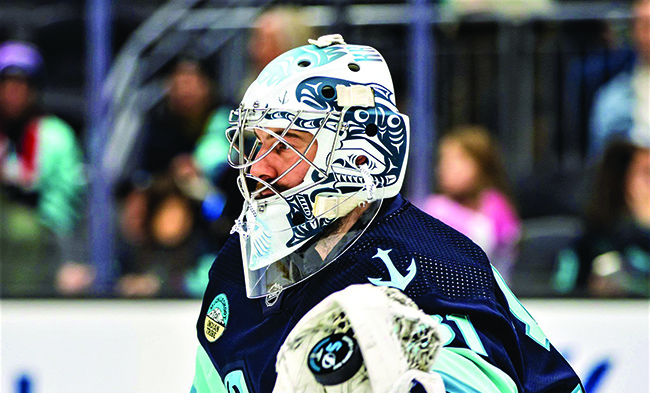
By Micheal Rios, Tulalip News
Merriam-Webster dictionary defines a New Year’s resolution as a promise to do something differently in the new year. That definition doesn’t really do justice for the true dream chasers out there. Individuals with the courage to take risks and push themselves beyond their perceived limits to achieve something incredible. For these types, resolutions are merely goal-oriented tasks that bring them one step closer to fulfilling a dream.
Enter Tulalip artist Ty Juvinel and his dream of fusing formline, the traditional art form of our Coast Salish ancestors, with his passion for the Washington’s professional sports scene. Following the newly minted Seattle Kraken officially announcing their team name and logo, in July 2020, it was a perfect blend of rhyme and reason for Ty to attempt to manifest his dream.
“The first helmet I did was simply a passion project. Something I wanted to do to challenge myself by creating something new,” recalled Ty. “I’m a big hockey fan. Other people may not view it this way, but I view hockey as an evolution of Lacrosse, which is an Indigenous sport. But also, if you do some research and look up Mic-Mac hockey sticks, you’ll find the best hockey sticks of the early twentieth century were made by First Nations people….[rest of quote]
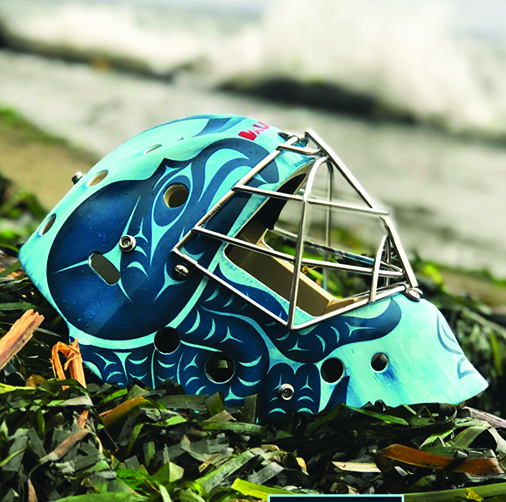
“After I finished the helmet I posted it online and shared with people close to the Kraken organization. Seemingly, there was no interest,” he divulged. “But that didn’t stop me from continuing to try and make my dream a reality.”
As 2020 rolled into 2021 and then 2022, a new development began to take form within the intersection of creativity and athletics. A new trend emerged as up-and-coming artists began finding unique opportunities to collaborate with professional sports teams. This innovative partnership is redefining the way sports and art converge, turning the gigantic fan bases of professional teams into a platform for artists to showcase their talents to a much broader audience.
Seattle Kraken vice-president of brand, Aaron Wiggan, recalled how it became a priority for to collaborate with local Indigenous artists. “It began by understanding how much representation matters. When we think about Seattle and the fabric of culture in this place, so much of it is rooted within the Coast Salish people and history. It’s something that really separates this region from other places across the United States.
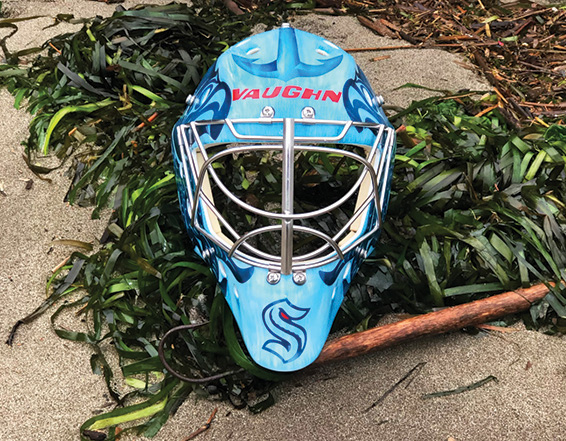
“It became a foundational component of who we want to be as a team, to connect with different communities, specifically tribal communities. There’s probably no better way for a mass audience to engage with, relate to, and understand a culture better than through art,” he added. “Ty is such a generous person. He showed up wanting to participate, willing to give a lot of himself and his artwork to us, but also desiring to share with us his history and his people’s history.”
More than two years after fusing formline and fandom, an opportunity afforded to him by Marysville local Bill Yates who sent him the initial mask to mock-up, Ty received an invitation by the Kraken to collaborate. What was just a farfetched idea planted by a Tulalip artisan strolling the sands of Mission Beach looking for inspiration was about to bloom into a true cross culture collaboration.
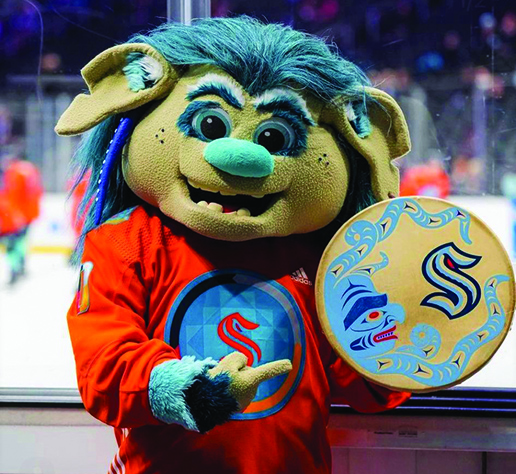
Ty began working closely with Aaron and his fellow members of the Kraken’s brand team to infuse his creative vision into various aspects of the team’s identity. This included several brainstorming sessions regarding custom traditional item with remixed Kraken imagery (paddle and drum), conceptualizing stunning Coast Salish awareness campaigns (land acknowledgement), and even designing iconic team merchandise (masks and jerseys) that resonate with local hockey fans on a deeper level. All while paying homage to the ever-vibrant tribal culture that remains omnipresent in our Coast Salish territory.
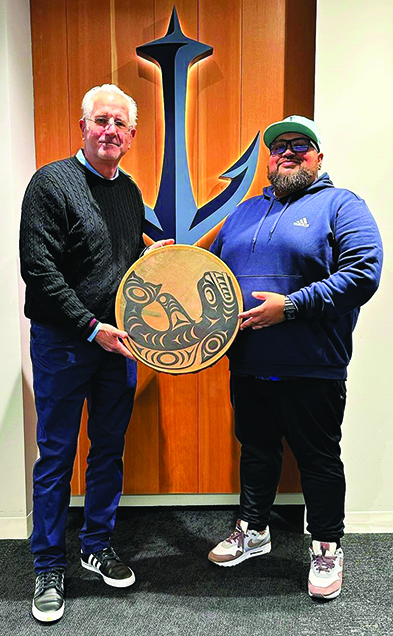
As fate would have it, Kraken CEO Tod Leiweke kept a carved and painted paddle gifted from Ty in his office. In a meeting between the CEO, Brand VP, and Kraken goalie Philipp Grubauer to discuss his desire to have a one-of-a-kind mask created for the team’s upcoming Indigenous People’s Night, Philipp spotted the paddle and asked, “Who made this?”
In the weeks after that fateful meeting, Philipp, who is a German citizen, would befriend Ty. Even going so far as to visit the Tulalip Reservation multiple times, including bringing his German parents with to visit the Hibulb Cultural Center while Ty offered his cultural perspective as tour guide. Philipp and Ty discussed design imagery for the intended mask, with each subsequent conversation serving to strengthen the bond between professional player and devout fan.
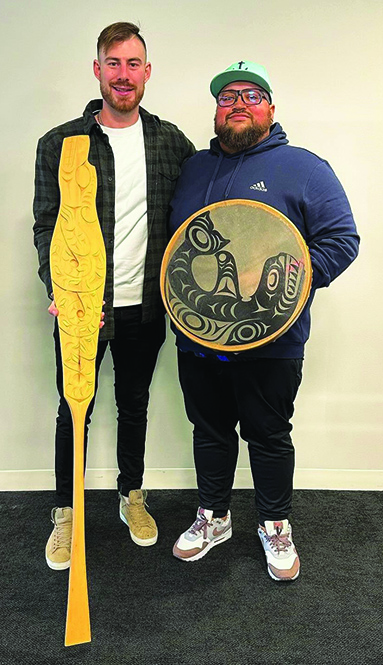
“Philipp really wanted something that represented all the Tribes in Washington State, which as we know is a difficult concept for such a small canvas like a goalie helmet, so I chose some iconic Coast Salish imagery,” explained Ty. “Using the air vent holes as eyes, there are Kraken with salmon spirits on each side, a spirit bird on the crown, a wolf along the chin strap, and on the back plate is a bear fishing for salmon. The design also includes a German eagle to represent Philipp’s ancestry.”
Upon receiving the freshly painted helmet and seeing all the fabulous formline gracing its contoured shape, Philipp, the 12-year NHL pro goalie, shared, “Unbelievable! This is one of the coolest masks or the coolest mask I’ve ever had. Incredible work. I’m so happy with it and so excited to wear it.”
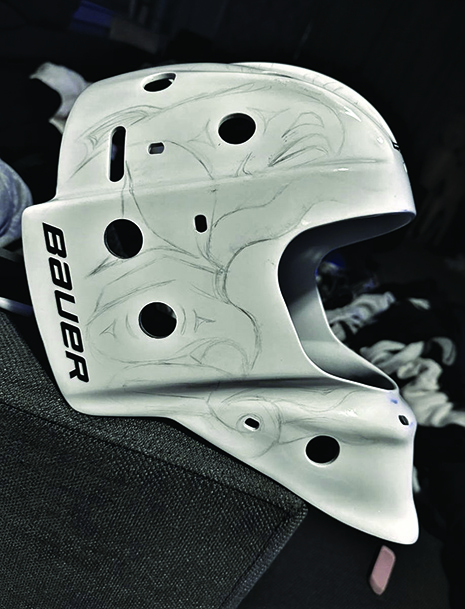
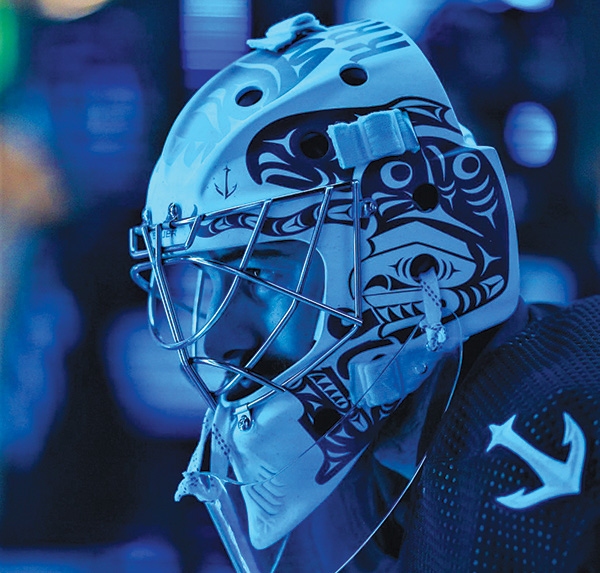
Ty’s mask made it’s professional debut last month, when the Kraken held their Indigenous People’s Night at Climate Pledge Arena on December 9. Among 17,000 fans in the sold-out arena was Ty and his family, including 13-year-old son Landon and 11-year-old daughter Teagan.
“Being able to share that moment with family was everything. I had tears in my eyes because it was such a powerful moment seeing our culture be recognized in a way that’s never happened before,” said Ty. “It’s recognition on a different level, a national level. How many people from around the continent watched that game and got to see our culture be recognized and honored? It’s powerful, that’s the best I can put it.
“Definitely a lot of emotion because this whole thing started as an idea I had for what it would look like if Seattle’s newest sports team used our art, our aesthetic to create their designs,” he continued. “It went from that idea to one phone call, a couple years later, inviting me to collaborate that made my dream a reality. Now, I can use this experience to tell my fellow artists and the ones coming up to never stop dreaming. I’m just a kid from the Rez. If I can do something like this, then others can, too.”
As the trend of up-and-coming artists collaborating with professional sports teams continues to gain momentum, the future looks promising for both worlds. This mutually beneficial relationship not only provides artists with unprecedented visibility, it also enriches the fan experience by introducing diverse visual elements to the world of sports.
“Philipp Grubauer only uses a two-mask rotation and Ty’s is one of them, so seeing his mask on TV will continue to be routine,” stated Aaron, Kraken Brand VP. “Ty is in a roster of pretty incredible artists, and we absolutely plan on continuing our partnership with him.”
Collaborations, like that between the Seattle Kraken and Tulalip’s own Ty Juvinel, are not just about creating beautiful visuals, which they absolutely do, but they are also about celebrating the shared passion that unites fans and artists alike. It’s an amazing fusion that unites love for the game with the power of artistic expression that can capture an entire culture.